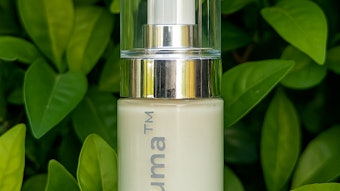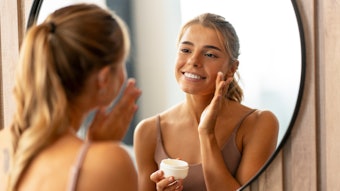“Beauty in the flesh will continue to rule the world.” —Florenz Ziegfeld
Whatever high-tech actives or exotic botanicals a skin treatment product may contain, the delivery system is still an essential key to the product’s effectiveness. In most cases, traditional emulsions are used. These emulsions break apart on the skin as their water content evaporates, and the material left behind either lays on the surface or tries to penetrate the outer layers of the skin. The assumption underlying cosmeceuticals is that active ingredients will indeed penetrate and maintain or repair the deeper layers of the skin. Other approaches are possible, such as microemulsions or the use of polymeric emulsifiers. Liposomes are also used to deliver actives, and several products on the market now use liquid crystal systems as the carrier. These systems are promoted as superior to traditional emulsions for moisturization and nourishment of the intercellular matrix. What’s to be made of these claims?
What are Liquid Crystals
Liquid crystals are all around you—take, for example, the numbers on digital watches and DVD players. Liquid crystals are an organized state of matter (thus crystal), but they can still flow (thus liquid), so they form a unique family of materials.
Liquid crystals can have different shapes. If they form flat sheets laying on each other, they are called lamellar. Liquid crystals in lamellar form result from the interaction of polar bilayers with water. These arrangements are classified as lyotropic because they rely on the action of a solvent. They can be destroyed by excess solvent or elevated temperatures. Soaps, detergents and polypeptides can form lyotropic liquid crystal systems—the slimy stuff that forms under a wet soap bar is an example.
Skin Structure
A simple way to look at skin structure is as a brick-and-mortar model. The two ways a chemical can penetrate the skin are directly through the bricks (transcellular) or through the mortar (intercellular). A liquid crystal emulsion, like most cosmetic ingredients, will take the intercellular path.
The skin cells are held together by the intercellular matrix (the mortar), which helps prevent moisture loss and creates the smooth appearance on the surface. This region is structured by liquid crystal regions, and lipids prevent evaporation and provide lubrication to the surface of skin. The intercellular matrix and the skin’s lipid content gives skin a good deal of its surface texture and feel. When the lipid content of skin is reduced, the result is surface roughness, flaking, fine lines and a tight, uncomfortable feeling. Moreover, the skin’s healing process is impaired.
To strengthen the intercellular region, or at the very least do no harm to its structure, an emulsion of highly compatible ingredients is called for. In fact, there is a complex mixture of chemicals that contribute to healthy, attractive skin, and, as ingredients, these include cholesterol, fatty acids, triglycerides, phospholipids, amino acids, linoleic acid and glycerine.
However, many surfactants—such as sodium lauryl sulfate—have the unfortunate ability to disrupt the matrix and, therefore, can be irritating. The trick, therefore, is simply getting the liquid crystal emulsion formulas and liquid crystal structures in the intercellular matrix together in an effective way.
Several products on the market claim benefits from their liquid crystal formulations. One product is marketed as a “soothing blend of nature’s perfect hydrators—jojoba oil and shea butter—in a unique liquid crystal formulation. [The] emulsion helps replenish the skin’s delicate liquid crystal matrix to revive dry, aging or recently resurfaced skin.” Do products such as this work? In a Cosmetics & Toiletries magazine story, In-Young Kim pointed out the sensitivity of liquid crystal structures to temperature, and to impact the intercellular matrix, the lipids must penetrate the mighty barrier of the stratum corneum.1 Based his studies, it is clear that liquid crystal emulsions can have superior moisturizing effects. Once inside the dermis, it is hoped that the emulsion components will interact with the natural lipid structures of the skin. Like so many aspects of treatment products, however, the efficacy of liquid crystal emulsions deep in the skin is a matter of reasonable theorizing substantiated with little or no clinical data.
Note, too, that liquid crystal cleansers are also on the market. They are essentially low water content surfactant systems that primarily function as makeup removers. One is a liquid crystal cleansing oil that requires the user to apply added water and then wash. Another such product is formulated to emulsify and dissolve dirt and makeup, rather than creating a lot of foam for removal.
It should be noted that foam, while certainly not a requirement of an effective cleanser, is still a characteristic most consumers expect. And liquid crystal cleansers seem to have very limited consumer acceptance.
At this time, liquid crystal technology, as a whole, doesn’t really have the dramatic marketing impact of the latest super fruit or miracle peptide. The performance benefits may be significant, but the chemistry is hard to communicate to a consumer overwhelmed by numerous hard to interpret cosmeceutical claims. Still, particularly with skin care aimed at the intercellular matrix, the potential superiority of liquid crystal formulations over conventional emulsifiers deserves the serious consideration.
References
- I Kim, et al, Liquid Crystal O/W Emulsions to Mimic Lipids and Strengthen Skin Barrier Function, Cosm & Toil June (2009)
- C Froebe et al., Prevention of stratum corneum lipid phase transitions in vitro by glycerol—An alternative mechanism for skin moisturization, JSCC, Jan/Feb 51–65 (1990)
- S Friberg, Micelles, microemulsions, liquid crystals, and the structure of stratum corneum lipids, JSCC, May/Jun 155–171 (1990)
Steve Herman is president of Diffusion LLC, a consulting company specializing in regulatory issues, intellectual property, and technology development and transfer. He is a principal in PJS Partners, offering formulation, marketing and technology solutions for the personal care and fragrance industry. He is an adjunct professor in the Fairleigh Dickinson University Masters in Cosmetic Science program and is a Fellow in the Society of Cosmetic Chemists.










